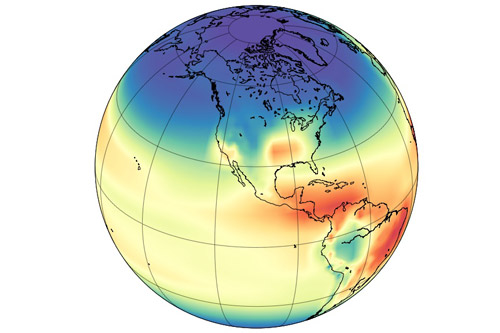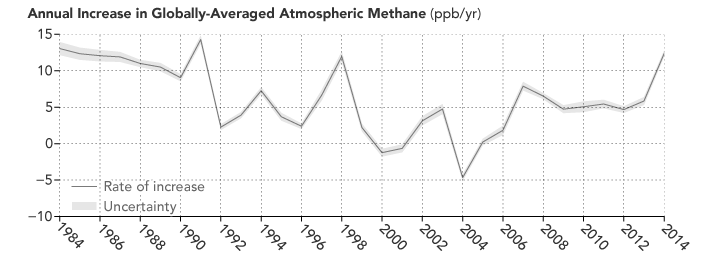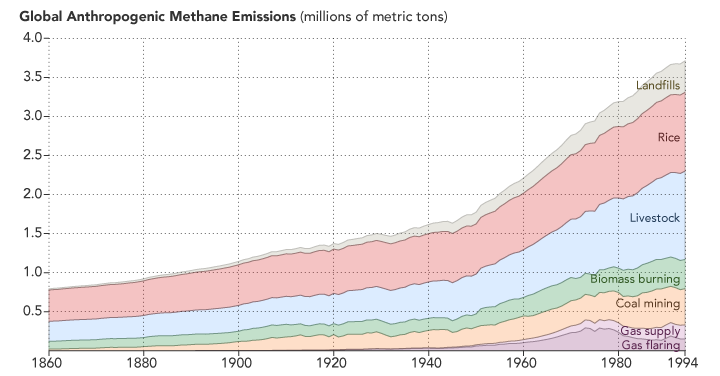
Model simulation of the hydroxyl radical concentration in the atmosphere. Image by Angharad Stell, University of Bristol.
A mystery about global methane trends just got more muddled. Two studies published in April 2017 suggest that recent increases in atmospheric concentrations of methane may not be caused by increasing emissions. Instead, the culprit may be the reduced availability of highly reactive “detergent” molecules called hydroxyl radicals (OH) that break methane down.
Understanding how globally-averaged methane concentrations have fluctuated in the past few decades—and particularly why they have increased significantly since 2007—has proven puzzling to researchers. As we reported last year:
“If you focus on just the past five decades—when modern scientific tools have been available to detect atmospheric methane—there have been fluctuations in methane levels that are harder to explain. Since 2007, methane has been on the rise, and no one is quite sure why. Some scientists think tropical wetlands have gotten a bit wetter and are releasing more gas. Others point to the natural gas fracking boom in North America and its sometimes leaky infrastructure. Others wonder if changes in agriculture may be playing a role.”
The new studies suggest that such theories may be off the mark. Both of them find that OH levels may have decreased by 7 to 8 percent since the early 2000s. That is enough to make methane concentrations increase by simply leaving the gas to linger in the atmosphere longer than before.

Atmospheric methane has continued to increase, though the rate of the increase has varied considerably over time and puzzled experts. (NASA Earth Observatory image by Joshua Stevens, using data from NOAA. Learn more about the image.)
As a press release from the Jet Propulsion Laboratory (JPL) noted: “Think of the atmosphere like a kitchen sink with the faucet running,” said Christian Frankenberg, an associate professor of environmental science and engineering at Caltech and a JPL researcher. “When the water level inside the sink rises, that can mean that you’ve opened up the faucet more. Or it can mean that the drain is blocking up. You have to look at both.”
Unfortunately, neither of the new studies is definitive. The authors of both papers caution that high degrees of uncertainty remain, and future work is required to reduce those uncertainties. “Basically these studies are opening a new can of worms, and there was no shortage of worms,” Stefan Schwietzke, a NOAA atmospheric scientist, told Science News.
You can find the full studies here and here. The University of Bristol has also published a press release.

Methane emissions related to human activity are on the rise. (NASA Earth Observatory image by Joshua Stevens, using data from CDIAC. Learn more.)
Tags: greenhouse gases, methane




In a recent lecture by a naturalist who frequently visits the tundra in northern latitudes, he reported on the snow melt that is uncovering the tundra and releasing methane. I do not see that on the graph. Is this insignificant or will it be a significant source of methane in the future?
http://cdiac.ornl.gov/trends/meth/ch4.htm
Thanks
Hello Wayne,
There is some more information about permafrost and gas hydrates as a source of methane here and here:
https://earthobservatory.nasa.gov/Features/MethaneMatters/#page5
https://earthobservatory.nasa.gov/Features/MethaneMatters/#page6
You would have to check with David Stern or Robert Kaufmann (the source of the data used in that particular chart) to be sure, but I suspect they either didn’t have good trend data available or there simply isn’t enough of an increase in emissions to be significant.
http://cdiac.ornl.gov/trends/meth/ch4.htm
Adam
Kindly translate to tamil
Arctic peat and methane hydrate as a source?!
No mention of the frozen methane melting and releasing more gas?
More ch4 would take more h-o out of the atmosphere and levels will be rising simultaneously.
Gustav makes an important point. Instead of reduced OH radicals increasing the CH4 level, as suggested by this post, the opposite may be true. Increased CH4 levels may be reducing the OH radical concentration. (OH radicals are used up when they break down CH4). If this is the case, then atmospheric CH4 measurements may be under-estimating the increase in emissions, due to the increased consumption of the OH radicals. This has aspects of a positive feedback loop – increased CH4 reduces OH levels, which leads to increased CH4 levels, etc.
Has anybody written an article trying to estimate the current Methane release rate in the Arctic? Has anybody even tried? The two satellite data feeds for MetOp-1 and MetOp-2 make it appear that there is a lot flowing up into the sky over the Arctic.
I’m sorry, I’m not a scientist but I think you might find even just Googling Arctic/methane might answer your startlingly naive question: ‘Has anybody written an article?’ There are thousands!
It’s said by suspected fossil fuel lobbyists and the idiots Trump has appointed to oversee environmental agencies that ‘scientists don’t agree’ over global warming, actually the problem is that the results don’t agree, inasmuch as the graphs tend to be polynomial – also it’s quite difficult to measure methane concentrations, it appears, as they vary considerably according to altitude.
What they all agree on is that Arctic methane emissions from both clathrates and rapidly thawing permafrost are horrific and dangerous and are very probably already in a runaway feedback loop that could according to the worst-case scenario produce 10 deg. C. warming by 2021. (Arctic News website 14 May).
You maybe need to wake up, Joseph!
A recent informative review paper addresses this in the context of repairing climate:
Earth Syst. Dynam., 8, 1–54, 2017
http://www.earth-syst-dynam.net/8/1/2017/
doi:10.5194/esd-8-1-2017
© Author(s) 2017. CC Attribution 3.0 License.
‘Climate engineering by mimicking natural dust climate
control: the iron salt aerosol method’
Franz Dietrich Oeste 1 , Renaud de Richter 2 , Tingzhen Ming 3 , and Sylvain Caillol 2
And another provocative news item in Science, May. 8, 2017 :
http://www.sciencemag.org/news/2017/05/methane-slowing-global-warming-arctic
“Are methane seeps in the Arctic slowing global warming?”
Clearly the science of methane in the atmosphere is far from settled!